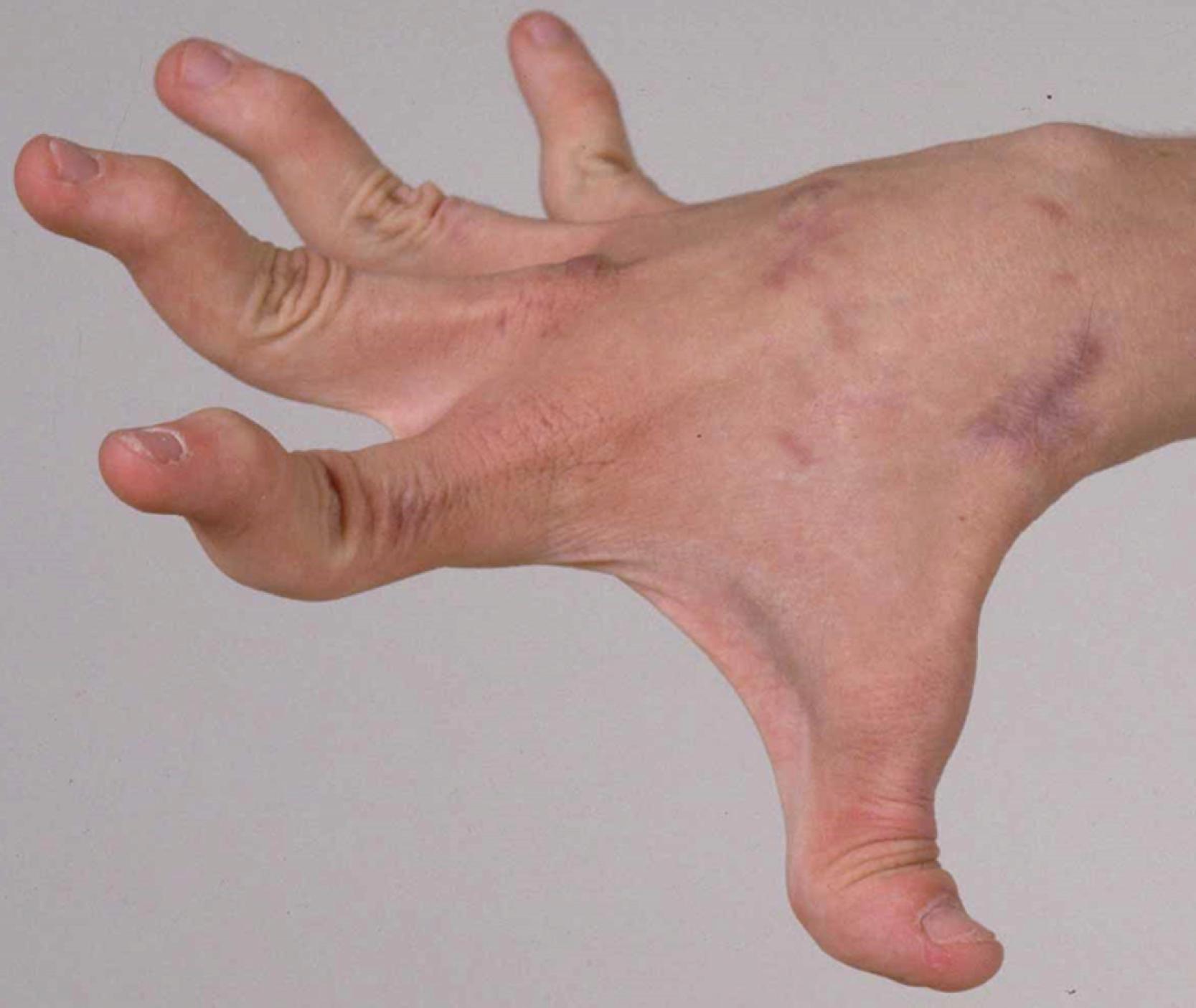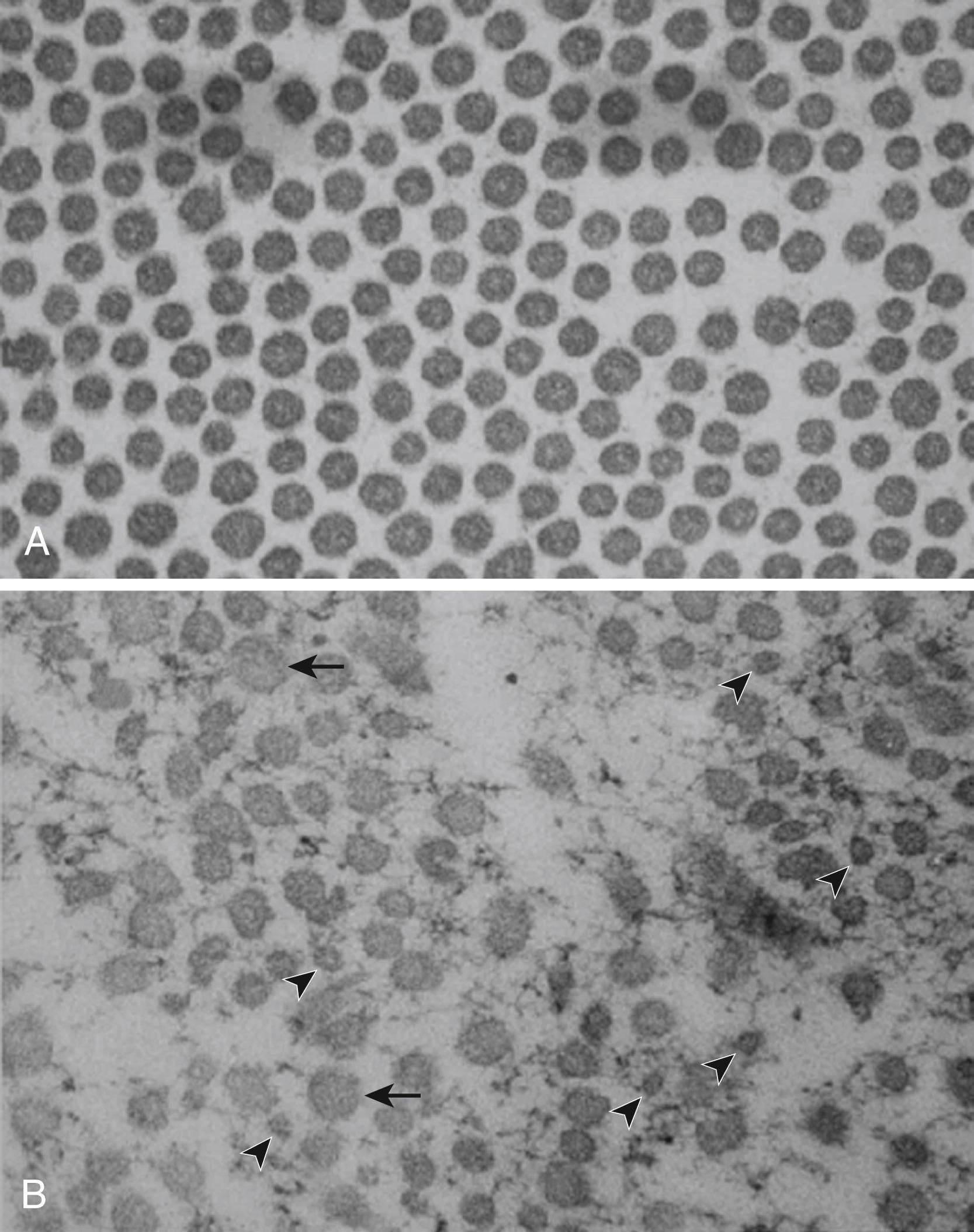Physical Address
304 North Cardinal St.
Dorchester Center, MA 02124
Many primary connective tissue disorders alter the radiographic appearance of the skeleton and are referred to as skeletal dysplasias (see Chapter 49 ). A smaller number of disorders produce connective tissue laxity syndromes, such as the Ehlers–Danlos syndrome, in which the major impact is on the structure and function of soft tissues such as ligaments, tendons, vessels, and skin. Others are characterized by limitation of joint movement. This chapter will describe some of the more important primary disorders of connective tissue that may present initially to a pediatric rheumatologist, with specific focus on syndromes associated with joint pain or limitation of motion that may suggest an initial diagnosis of an inflammatory arthritis ( Box 54.1 ).
More than one family member affected
Family history of joint replacement at an early age (<40 years old)
Absence of evidence of systemic or synovial inflammation
Absence of antinuclear antibodies (ANAs) and rheumatoid factor
Absence of joint erosions despite chronic disease
Congenital camptodactyly
Generalized hypermobility
Presence of two or more dysmorphic features
Excessively mobile joints may be painful with or without swelling. The 1998 revised Brighton criteria (see Chapter 50 ) are used to define patients with benign hypermobile joint (BHMJ) syndrome. There are limited data to indicate the frequency of BHMJ, but an estimate of 1:5000 has been proposed in association with musculoskeletal pain. It appears to be more frequent in women and in children and varies in frequency from one racial group to another. In addition to the common BHMJ, a number of rare congenital and familial syndromes are associated with hypermobile joints and may present to the pediatric rheumatologist. Some of the more important syndromes are discussed in the following paragraphs.
The Ehlers–Danlos syndromes (EDS) comprise a heterogeneous group of disorders characterized by soft tissue laxity of varying degree, particularly affecting the dermis and joints. The 2017 International Classification shown in Table 54.1 is based on clinical phenotype and gene mutations that result in abnormal collagen fibrils in affected soft tissues. Malfait et al. proposed regrouping of EDS according to underlying genetic and pathogenic mechanisms: A detailed description of the clinical phenotype, diagnostic criteria, collagen abnormality, and genetics of each of the 13 subtypes of EDS is provided in the reference.
| Clinical EDS Type | Inheritance | Genetic Basis | Affected molecule |
|---|---|---|---|
|
|
|
|
|
|
||
|
|
|
|
|
|
|
|
|
|
|
|
|
|
||
|
|
|
|
|
|
|
|
|
|
|
|
|
|
|
|
|
|
||
|
|
|
|
|
|
|
|
|
|
||
|
|
||
|
|
|
|
|
|
||
|
|
|
|
|
|
|
|
|
|
Abnormalities of collagen fibril structure were observed by transmission electron microscopy of dermal samples from the severely lax and fragile skin of patients with classical EDS ( Figs. 54.1 and 54.2 ). These findings led to investigations of the extracellular matrix of the dermis, which shares many components with other affected tissues, such as ligaments, joint capsules, tendons, blood vessels, heart valves, cornea, sclera, adventitial layers of viscera, septa, and fascia. Of particular interest in the early studies, was the synthesis and assembly of the heterotypic collagen fibrils, which contain predominately type I collagen, moderate amounts of type III collagen, and minor amounts of type V collagen. Vascular tissues and cornea can contain up to 30% of type III or type V collagen, respectively. The underlying molecular abnormalities also involve proteoglycans and other proteins that bridge between the various components of the extracellular matrix as outlined in the following paragraphs.


Defects in type I collagen (COL1A1 and COL1A2), type III collagen (COL3A1), and type V collagen (COL5) have been identified in EDS subtypes ( Table 54.1 ). The first biochemical anomaly identified in humans with kyphoscoliotic EDS, and an animal model with EDS was a deficient in lysyl hydroxylase ( PLOD1 ). , This enzyme is required for the hydroxylation of lysyl residues of collagens, including those that are involved in the generation of glycosylated hydroxylysyl residues and hydroxylysyl-derived collagen cross-links. Kyphoscoliotic EDS is characterized by severe kyphoscoliosis, joint hypermobility, and fragility of vasculature and the eye.
A bovine model with severe skin fragility (dermatosparaxis) provided further evidence of the importance of collagen fibrillogenesis in the pathogenesis of EDS. Dermatosparactic cattle have an autosomal recessive deficiency of ADAMTS2, an enzyme that participates in the posttranslational processing of procollagen to collagen, resulting in impaired formation of collagen fibrils in type I collagen-containing tissues. In 1992 a human form of dermatosparaxis, type VIIC, was identified with autosomal recessive inheritance of ADAMTS2 mutations, with severe skin fragility, joint hypermobility, and blue sclerae. , Severe phenotypes are associated with nonsense mutations and complete loss of enzyme; milder phenotypes are associated with some residual enzyme activity in those with missense mutations of ADAMTS2. Patients with arthrochalasia multiplex congenita have autosomal dominant mutations involving the ADAMTS2 enzyme cleavage sites of the amino-terminal propeptides of either the pro-α1(I) or pro-α2(I) chains of type I procollagen. Mutations of this region of the pro-α1(I) chain are classified as arthrochalasia EDS.
Osteogenesis imperfecta (OI), a syndrome very unlike EDS, also results from different mutations in COLA1 or COLA2. It is one of the most common heritable disorders of connective tissue (one case in approximately 10,000 to 13,000 births) and is inherited in either an autosomal dominant or an autosomal recessive manner. Each of the subtypes of OI is characterized by joint hypermobility, but early and recurrent fractures of long bones are the overwhelming clinical manifestation. , Blue sclerae and dentinogenesis imperfecta are often present.
Joint laxity is a common feature of children with OI because of nonsense and missense mutations of the type I collagen. However, joint and skin laxity can be more severe in those with amino acid substitutions near the amino-terminal end of the helical domains of the type I collagen chains. The overlapping OI and EDS phenotypes of such children appear to be the result of conformational changes in the procollagen molecules that impair the ADAMTS2 cleavage of their amino-terminal propeptides. Type I collagen mutations have also been recorded in two other forms of EDS. Homozygosity or compound heterozygosity for null mutations of COL1A2 were detected in individuals with cardiac valvular EDS and laxity of the skin and joints. A small number of individuals with features of classical type I/II EDS and vascular ruptures had substitutions of arginine by cysteine within the triple helical domain of pro-α1(I) chains. An autosomal recessive form of EDS with scoliosis, joint hypermobility, and myopathy was shown to result from mutations of FKBP14, which encodes a member of the prolyl cis-trans isomerase family. It is likely that the deficiency in this enzyme impairs cis-trans isomerization of peptidyl-prolyl bonds, which is an essential process in the normal folding of fibrillar collagens.
Mutations of type III collagen, COL3A1, are found in vascular EDS. Affected individuals have thin translucent skin, wide scars with prominent subcutaneous veins, easy bruising, vascular fragility, and potential for bowel rupture. Mild joint hypermobility is usually limited to the hands. Affected individuals have a significant risk of acute vascular ruptures and death.
The phenotypic impact of COL3A1 mutations on the vascular system probably reflects the much higher proportion of type III collagen in the heterotypic type I collagen fibrils of the vascular system compared with other connective tissues. To date, there is only a single report of an autosomal recessive inheritance of biallelic COL3A1 mutations in vascular EDS.
Type V collagen, present in minor amounts within heterotypic type I collagen fibrils, plays an important role in limiting the size of the heterotypic type I collagen fibrils. It is found in greatest concentration in the cornea, where it is proposed to strictly control collagen fibril sizes in order to maximize transmission of light.
Most individuals with classical type EDS have autosomal dominant mutations of the COL5A1 or COL5A2 genes that encode the pro-α1(V) and pro-α2(V) chains of type V procollagen, respectively. Most mutations result in COL5A1 haploinsufficiency. Mutations of COL5A2 are less frequently found and are usually missense mutations. COL5A1 knockout mice do not survive embryogenesis and their tissues lack large collagen fibrils.
Proteoglycans, such as decorin and biglycan, are important extracellular matrix components of the dermis and other connective tissues. Progeroid (spondylodysplastic) EDS results from impaired addition of glycosaminoglycans to several proteoglycan core proteins resulting from autosomal recessive mutations of B4GALT7. This gene encodes galactosyltransferase I, which transfers galactose to the O -linked xylose of the core proteins. Autosomal recessive mutations of B3GALT6, a related gene involved in the synthesis of galactosyltransferase II, is associated with joint laxity and contractures, skin fragility, and spondyloepimetaphyseal dysplasia.
Musculocontractural EDS has clinical features similar to those of kyphoscoliotic EDS. It results from autosomal recessive mutations in CHST14, which encodes dermatan 4- O -sulfotransferase I, an enzyme that sulfates N -acetylgalactosamine residues in dermatan sulfate side chains.
Mutations of TNXB, which encode tenascin X protein within the extracellular matrix of connective tissues, result in tenascin X deficient EDS. Tenascin X deficient EDS resembles classical EDS except that skin healing is normal. Studies in TNXB -null mice suggest that tenascin X plays a role in collagen deposition and in bridging interactions with fibrillar collagens, fibril-associated collagens, decorin, and other matrix proteins.
A phenotype of lax skin, easy bruising, and spondylocheiro (spine and hand) dysplasia resulting from autosomal recessive mutations of SLC39A13 and/or B4GALT7 or B3BALT6 is recognized as a distinct subtype ( spondylodysplastic EDS ) in the current classification. SLC39A13 encodes ZIP13, a zinc transporter. It appears that deficient availability of zinc may have pleiotropic effects as shown by the combined EDS and skeletal dysplasia phenotypes.
Become a Clinical Tree membership for Full access and enjoy Unlimited articles
If you are a member. Log in here